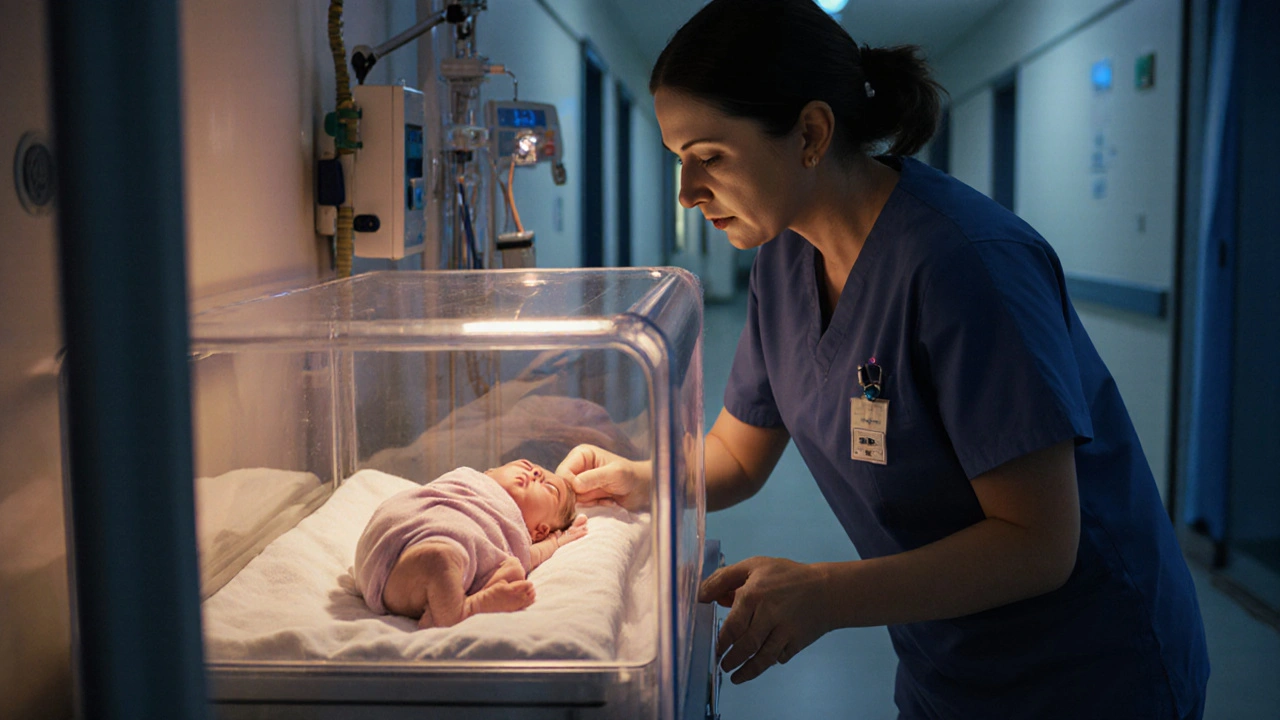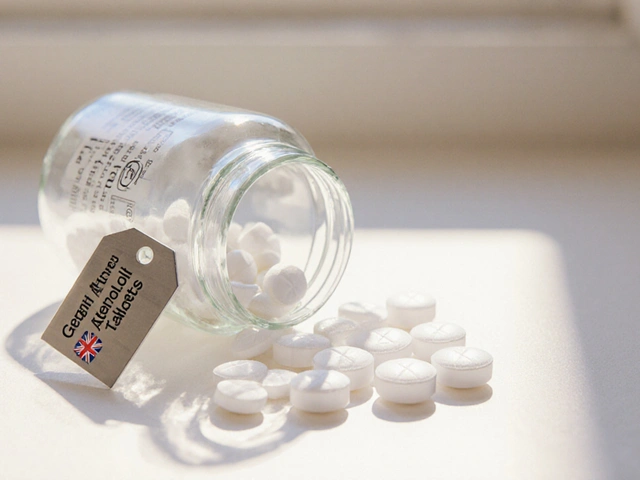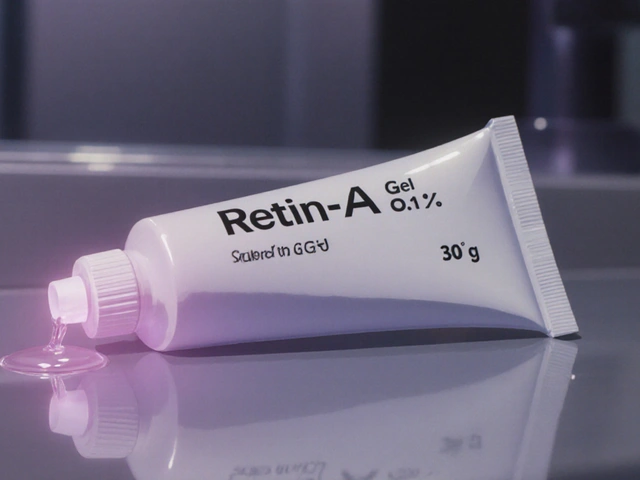Neonatal seizure is a sudden, abnormal electrical discharge in the brain of a baby younger than 28 days that may appear as a visible movement or be hidden on the surface, often signaling an underlying medical issue.
Why Early Detection Matters
Newborn brains are still wiring themselves, so a single electrical storm can disrupt critical pathways. Studies from leading pediatric centers show that infants whose seizures are treated within the first hour have a 30% lower risk of long‑term neurodevelopmental impairment. In practice, the biggest hurdle is that many seizures are subtle seizures-brief eye‑blinks, lip‑smacking, or a fleeting change in breathing-easily missed by busy NICU staff.
How to Spot the Different Types
Clinicians categorize newborn seizures into four main patterns:
- Clonic seizures: rhythmic jerking of a limb or the whole body, usually lasting 10‑30 seconds.
- Tonic seizures: sustained stiffening of the arms, legs, or trunk, often lasting less than 10 seconds.
- Benign neonatal sleep myoclonus: harmless jerks that occur only during sleep and disappear with awakening.
- Subtle seizures: brief autonomic changes (e.g., tachycardia, apnea), eye deviation, or facial twitching. These are the most common-accounting for up to 60% of all neonatal seizures.
Because subtle seizures can be invisible to the naked eye, you need a reliable monitoring tool.
EEG Monitoring: The Gold Standard
The electroencephalogram (EEG) records electrical activity from the scalp and can detect both clinical and electrographic-only seizures. A 2024 multicenter review found that continuous video‑EEG captured 45% more seizure events than bedside observation alone. When a newborn is admitted to the Neonatal Intensive Care Unit (NICU), the typical protocol is:
- Place a minimum of 10 electrodes within the first hour of suspicion.
- Startcontinuous video‑EEG for at least 24hours.
- Have a pediatric neurologist review the trace every 6hours or sooner if clinical changes arise.
Quick EEG interpretation can differentiate true seizures from benign movements, preventing unnecessary medication.
Underlying Causes You Can’t Ignore
Neonatal seizures rarely occur in isolation. Common etiologies include:
- Hypoxic‑ischemic encephalopathy (HIE): oxygen deprivation during birth, accounting for 30-40% of cases.
- Metabolic disturbances such as hypoglycemia, hypocalcemia, or severe hypernatremia.
- Intraventricular hemorrhage or other structural brain injuries.
- Inherited channelopathies and rare genetic mutations.
Identifying the trigger directs therapy: for HIE, therapeutic hypothermia is standard; for metabolic issues, correcting the serum abnormality often stops the seizures.
First‑Line Anticonvulsant Therapy
When a seizure is confirmed, the goal is rapid seizure control with the fewest side effects. Over the past decade, three drugs dominate the neonatal formulary:
| Drug | Typical Loading Dose | Onset of Action | Reported Efficacy (seizure cessation) | Main Side Effects |
|---|---|---|---|---|
| Phenobarbital | 20mg/kg IV | 15-30min | ≈60% | Respiratory depression, sedation |
| Levetiracetam | 40mg/kg IV | 5-10min | ≈70% | Minimal; occasional irritability |
| Diazepam | 0.2mg/kg IV | 2-5min | ≈50% | Hypotension, respiratory suppression |
Historically, Phenobarbital was the default, but recent randomized trials show that Levetiracetam achieves higher seizure freedom with a cleaner side‑effect profile. Many NICUs now start with levetiracetam, reserving phenobarbital for refractory cases.
Step‑by‑Step Management Algorithm
- Stabilize airway and breathing. Initiate CPAP or mechanical ventilation if apnea is present.
- Obtain a blood gas and basic metabolic panel to rule out hypoxia, acidosis, or electrolyte shifts.
- Start continuous video‑EEG within 60minutes of suspicion.
- If EEG confirms a seizure, give the first loading dose of Levetiracetam (40mg/kg). Re‑assess EEG after 10minutes.
- If seizures persist, add a second loading dose of Phenobarbital (20mg/kg).
- For refractory seizures (>30minutes despite two agents), consider continuous infusion of midazolam or barbiturate coma under specialist guidance.
- Address the underlying cause simultaneously: initiate therapeutic hypothermia for HIE, correct glucose, calcium, or sodium as needed.
This algorithm compresses the decision‑making timeline to under two hours, which aligns with the “golden window” identified in recent outcome studies.
Monitoring and Follow‑Up
After acute control, infants need ongoing assessment:
- Repeat EEG at 24‑hour intervals for the first three days to catch late‑onset seizures.
- Neuroimaging (cranial ultrasound or MRI) within the first week to document structural injury.
- Developmental screening at 3, 6, and 12months using standardized tools such as the Bayley Scales.
Families should be counseled about the potential for epilepsy later in childhood-about 10‑15% of babies with neonatal seizures develop recurrent seizures after age two.
Related Concepts and Next Steps
Understanding neonatal seizures opens the door to a broader knowledge network. Key linked topics include:
- Seizure threshold in the developing brain.
- The role of genetic testing for channelopathies when seizures are refractory.
- Long‑term neuroprotective strategies beyond hypothermia, such as erythropoietin administration.
- Family support resources for parents navigating NICU uncertainty.
Readers who want to go deeper can explore "Management of Hypoxic‑Ischemic Encephalopathy" or "Genetic Causes of Early‑Onset Epilepsy" as logical next topics.

Frequently Asked Questions
What are the safest signs that a newborn might be having a seizure?
Look for repetitive eye‑rolling, brief pauses in breathing, sudden jerks of a single limb, or a sudden change in skin color. When in doubt, request a video‑EEG-subtle seizures often hide behind these cues.
How quickly should treatment start after a seizure is confirmed?
Ideally within the first hour. Studies show that every 30‑minute delay raises the risk of permanent brain injury by roughly 10%.
Is phenobarbital still used, or has it been replaced?
Phenobarbital remains a backup drug for seizures that don’t respond to levetiracetam. Its long half‑life is useful for maintenance, but it can cause sedation, so many centers reserve it for refractory cases.
Can metabolic problems trigger seizures, and how are they fixed?
Yes. Low blood sugar, calcium, or extreme sodium levels can provoke seizures. Rapid correction-IV dextrose for hypoglycemia, calcium gluconate for hypocalcemia, or careful fluid management for hypernatremia-often stops the seizures without drugs.
What long‑term follow‑up is needed after a neonatal seizure?
Regular EEGs for the first week, brain imaging, and developmental assessments at 3, 6, and 12 months are standard. Pediatric neurologists usually continue monitoring until school age to catch any emerging epilepsy early.
Does therapeutic hypothermia reduce seizure burden?
In infants with moderate to severe HIE, cooling the body to 33.5°C for 72hours cuts the incidence of seizures by about 40% and improves neurodevelopmental outcomes.







Vaibhav Sai
September 27, 2025 AT 13:31Wow, this post really dives deep into the tiny world of newborn seizures, and it's packed with useful nuggets, like how a 30‑minute delay can hike up brain‑injury risk by about ten percent! The breakdown of seizure types was crystal‑clear, especially that subtle category that hides behind eye‑blinks and tiny breaths. I love the step‑by‑step algorithm-starting with airway, then labs, then that lightning‑fast levetiracetam dose. The EEG timeline feels like a race against the clock, and the data about video‑EEG catching 45 % more events is eye‑opening. Kudos for pulling together the meds table; it makes the trade‑offs between phenobarbital and levetiracetam a breeze to compare.
Lindy Swanson
October 6, 2025 AT 19:45Sounds like overkill.
Amit Kumar
October 16, 2025 AT 01:58Totally agree! 😊 The emoji vibe might seem silly, but those little visual cues can actually help remind us to watch for those fleeting facial twitches. Plus, sharing the excitement about early EEG can motivate NICU teams to push for quicker setups. Let’s keep spreading the word-every second counts!
Crystal Heim
October 25, 2025 AT 08:11Some points are overstated, the evidence isn’t as clear as presented.
Sruthi V Nair
November 3, 2025 AT 13:25When we think of a newborn’s brain, it’s almost philosophical-an unfinished poem that a seizure can abruptly alter. Yet the data suggests we can intervene before the stanza is ruined, if we listen closely to those subtle cues. It raises the question: how much of our current protocol is cultural habit versus true necessity?
Mustapha Mustapha
November 12, 2025 AT 19:38I’ve seen similar protocols in my unit, and the emphasis on rapid EEG is spot‑on. The balance between aggressive treatment and avoiding sedation is a delicate dance.
ravi kumar
November 22, 2025 AT 01:51India’s neonatal units need to adopt these standards fast, otherwise we lag behind. Our own guidelines still rely heavily on phenobarbital first.
SandraAnn Clark
December 1, 2025 AT 08:05Too much info.
Rex Wang
December 10, 2025 AT 14:18Exactly! The cascade you described-airway, labs, EEG-makes perfect sense, and the timing you highlighted (within the first hour) is crucial. This kind of clarity helps even the busiest clinicians keep the priority straight.
mark Lapardin
December 19, 2025 AT 20:31The pharmacokinetic profiles you listed are spot‑on; levetiracetam’s rapid onset and favorable side‑effect spectrum certainly justify its front‑line status. However, clinicians must stay aware of dosing nuances in preterm infants, where volume of distribution can differ markedly.